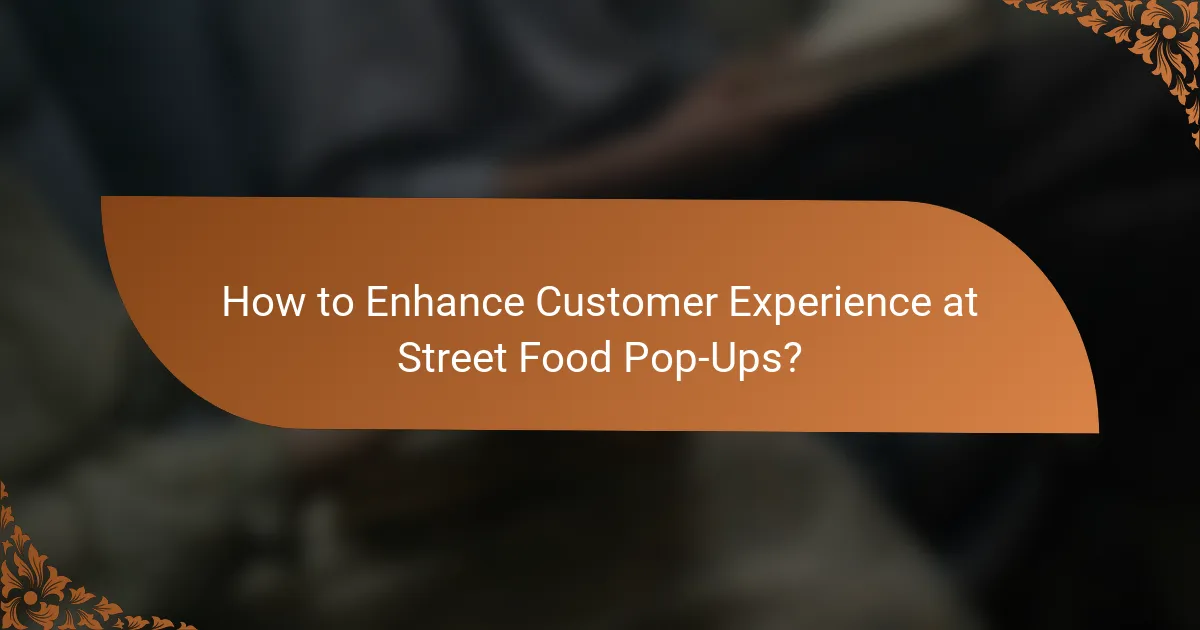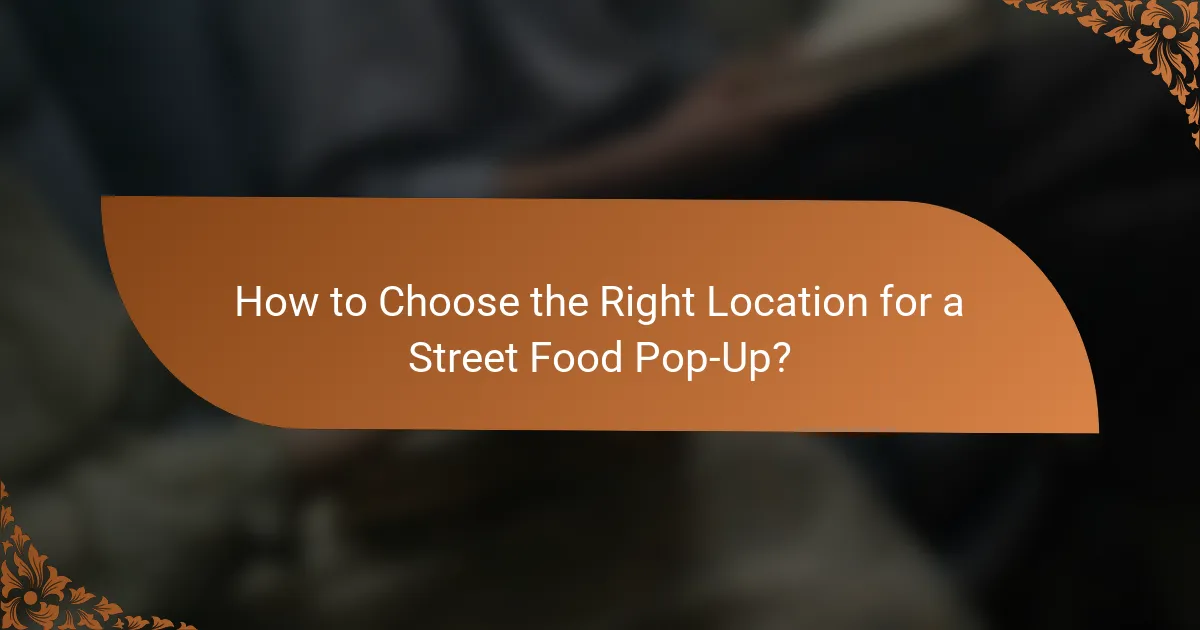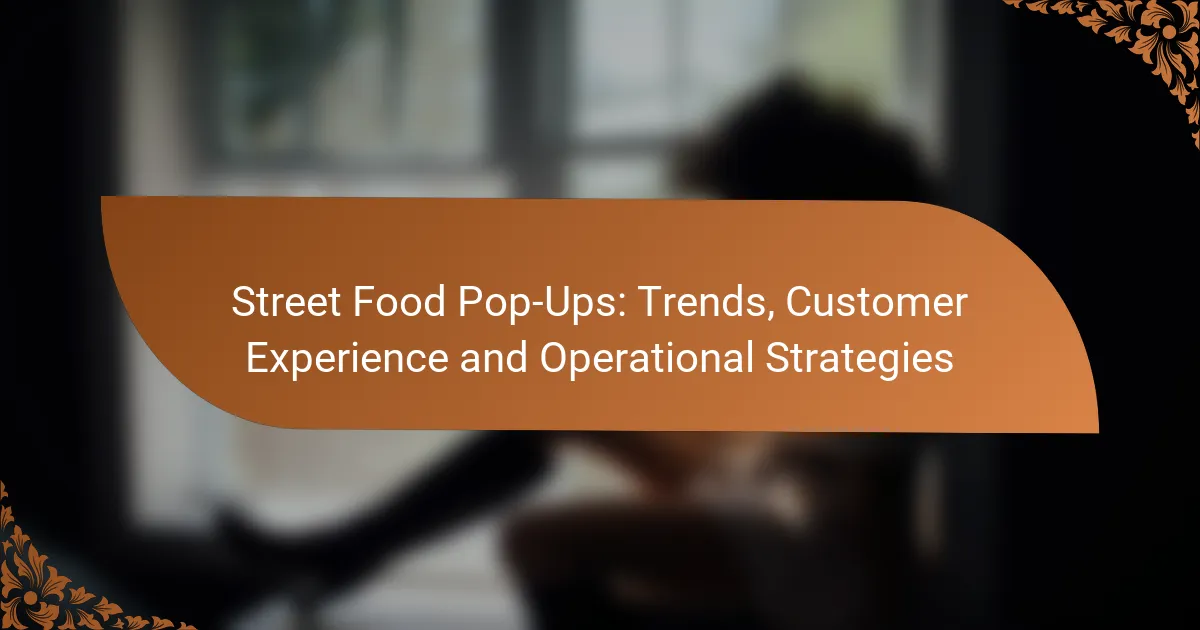Street food pop-ups are rapidly evolving to meet changing consumer preferences, emphasizing health-conscious options and innovative fusion cuisines. To enhance customer experience, vendors are creating engaging environments and streamlining the ordering process, which fosters loyalty and encourages repeat visits. Successful operations also depend on effective strategies such as supply chain management and flexible menu planning to adapt to market demands.

What Are the Key Trends in Street Food Pop-Ups?
Street food pop-ups are increasingly influenced by evolving consumer preferences and market dynamics. Key trends include a focus on health-conscious offerings, innovative fusion cuisines, technology integration, local sourcing practices, and seasonal menus that cater to diverse tastes.
Health-Conscious Offerings
Health-conscious offerings are becoming essential in street food pop-ups as consumers prioritize nutrition. Vendors are incorporating fresh ingredients, plant-based options, and lower-calorie alternatives to attract health-aware customers.
For example, a pop-up might feature quinoa bowls, vegan tacos, or gluten-free desserts, appealing to those with dietary restrictions. Emphasizing organic and non-GMO ingredients can further enhance the appeal.
Fusion Cuisine Innovations
Fusion cuisine innovations are redefining traditional street food by blending flavors and techniques from various cultures. This trend allows vendors to create unique dishes that stand out in a competitive market.
Examples include Korean BBQ tacos or Indian-inspired pizza, which not only attract adventurous eaters but also encourage social media sharing. Experimenting with unexpected combinations can lead to signature dishes that become customer favorites.
Technology Integration
Technology integration is transforming the operational aspects of street food pop-ups. From mobile payment systems to online ordering platforms, tech solutions enhance customer convenience and streamline transactions.
Using social media for marketing and engagement is also crucial. Vendors can leverage platforms like Instagram to showcase their offerings, share customer experiences, and announce pop-up locations, driving foot traffic and brand loyalty.
Local Sourcing Practices
Local sourcing practices are gaining traction as consumers increasingly value sustainability and community support. Street food vendors are sourcing ingredients from nearby farms and markets, which not only reduces carbon footprints but also fosters local economies.
Highlighting these practices in marketing materials can resonate with environmentally conscious customers. For instance, a vendor might promote their use of locally sourced produce, which enhances freshness and flavor.
Seasonal Menus
Seasonal menus allow street food pop-ups to capitalize on the freshest ingredients available, appealing to customers seeking variety. By changing offerings based on seasonal produce, vendors can create excitement and anticipation among patrons.
For example, a summer menu might feature refreshing salads and cold beverages, while winter could bring hearty soups and warm dishes. This approach not only enhances the dining experience but also supports local farmers by using in-season ingredients.

How to Enhance Customer Experience at Street Food Pop-Ups?
Enhancing customer experience at street food pop-ups involves creating an engaging environment, streamlining the ordering process, and actively involving customers in the experience. By focusing on these elements, vendors can foster loyalty and encourage repeat visits.
Interactive Ordering Systems
Implementing interactive ordering systems can significantly improve customer experience at street food pop-ups. Options like mobile apps or QR code menus allow customers to place orders quickly and efficiently, reducing wait times and enhancing satisfaction.
Consider integrating payment options such as mobile wallets or contactless payments to streamline transactions. This not only speeds up the process but also caters to tech-savvy customers who prefer digital solutions.
Unique Ambiance Creation
Creating a unique ambiance is essential for attracting and retaining customers at street food pop-ups. Use vibrant decorations, themed music, and comfortable seating to create an inviting atmosphere that encourages customers to linger and enjoy their meals.
Incorporate local art or cultural elements to resonate with the community and enhance the overall experience. This connection can make the pop-up feel more authentic and memorable, encouraging word-of-mouth promotion.
Customer Engagement Strategies
Engaging customers actively can lead to a more enjoyable experience and increased loyalty. Consider hosting events like cooking demonstrations or tasting sessions to involve customers and create a sense of community.
Utilize social media to interact with customers before, during, and after their visit. Encourage them to share their experiences online, and respond to their feedback promptly to show that their opinions matter. This two-way communication can enhance customer relationships and drive repeat business.

What Operational Strategies Drive Success?
Successful street food pop-ups rely on effective operational strategies that enhance efficiency and customer satisfaction. Key strategies include managing the supply chain, training staff, and planning flexible menus to adapt to changing demands.
Efficient Supply Chain Management
Efficient supply chain management is crucial for street food pop-ups to ensure consistent quality and availability of ingredients. Establishing strong relationships with local suppliers can reduce costs and improve freshness, which is vital in the competitive food market.
Consider implementing a just-in-time inventory system to minimize waste and ensure that ingredients are used while they are still fresh. Regularly reviewing supplier performance and adjusting orders based on sales trends can help maintain efficiency.
Staff Training Programs
Comprehensive staff training programs are essential for maintaining high service standards and operational efficiency. Training should cover food safety, customer service, and cooking techniques to ensure that all team members can deliver a consistent experience.
Consider ongoing training sessions and cross-training staff in different roles to enhance flexibility. This approach allows for better coverage during busy periods and helps staff adapt to various tasks, improving overall productivity.
Flexible Menu Planning
Flexible menu planning allows street food pop-ups to quickly adapt to customer preferences and seasonal ingredient availability. Offering a core menu with rotating specials can attract repeat customers while keeping the offerings fresh and exciting.
Monitor customer feedback and sales data to identify popular items and adjust the menu accordingly. This strategy not only meets customer demands but also helps manage inventory effectively, reducing waste and maximizing profit margins.

What Are the Best Practices for Marketing Street Food Pop-Ups?
Effective marketing for street food pop-ups involves leveraging social media, collaborating with local influencers, and participating in community events. These strategies help create visibility, engage potential customers, and enhance the overall experience.
Social Media Campaigns
Social media campaigns are essential for promoting street food pop-ups. Platforms like Instagram and Facebook allow vendors to showcase their offerings through vibrant images and engaging stories. Regular updates about menu changes, location, and special events can significantly boost customer interest.
Utilizing targeted ads can also help reach specific demographics, ensuring that the marketing efforts resonate with the intended audience. Consider using local hashtags to increase visibility among nearby potential customers.
Collaborations with Local Influencers
Partnering with local influencers can amplify the reach of street food pop-ups. Influencers often have dedicated followings that trust their recommendations, making them effective advocates for your brand. Choose influencers whose audience aligns with your target market to maximize impact.
Offering complimentary meals or exclusive tasting events can incentivize influencers to share their experiences. This not only generates buzz but also provides authentic content that can be shared across various platforms.
Event Participation Strategies
Participating in local events is a powerful way to market street food pop-ups. Look for food festivals, farmers’ markets, or community gatherings where you can set up a stall. These events attract large crowds and provide an opportunity to showcase your food directly to potential customers.
When planning for events, ensure you have a clear strategy for engaging with attendees. Offering samples, running contests, or providing special discounts can entice people to try your food and follow your social media accounts for future updates.

How to Choose the Right Location for a Street Food Pop-Up?
Choosing the right location for a street food pop-up is crucial for attracting customers and ensuring profitability. Key factors include foot traffic, local demographics, and competition in the area.
Assessing Foot Traffic
High foot traffic areas, such as busy streets, parks, or near popular attractions, can significantly boost visibility and sales. Monitor peak times and days to identify when the most potential customers are present.
Consider using tools like foot traffic apps or local data reports to analyze patterns. Locations near public transport hubs or events can also enhance customer flow.
Understanding Local Demographics
Understanding the local demographics helps tailor your offerings to the tastes and preferences of the community. Research the age, income, and cultural background of the area to align your menu with customer expectations.
For example, a pop-up in a college area might benefit from affordable, quick meals, while a location near affluent neighborhoods may allow for gourmet options. Engaging with local residents can provide valuable insights.
Evaluating Competition
Analyzing the competition is essential to determine if the location is saturated with similar offerings. Identify nearby food vendors and assess their strengths and weaknesses.
Consider differentiating your menu or service style to stand out. If competition is high, look for unique selling points, such as specialty dishes or unique cooking methods, to attract customers.
Legal and Regulatory Considerations
Before setting up a pop-up, familiarize yourself with local regulations and permits required for street food vendors. Requirements can vary significantly by city or region, impacting where you can operate.
Check for health and safety regulations, zoning laws, and necessary licenses. Engaging with local authorities early can help streamline the process and avoid potential fines.
